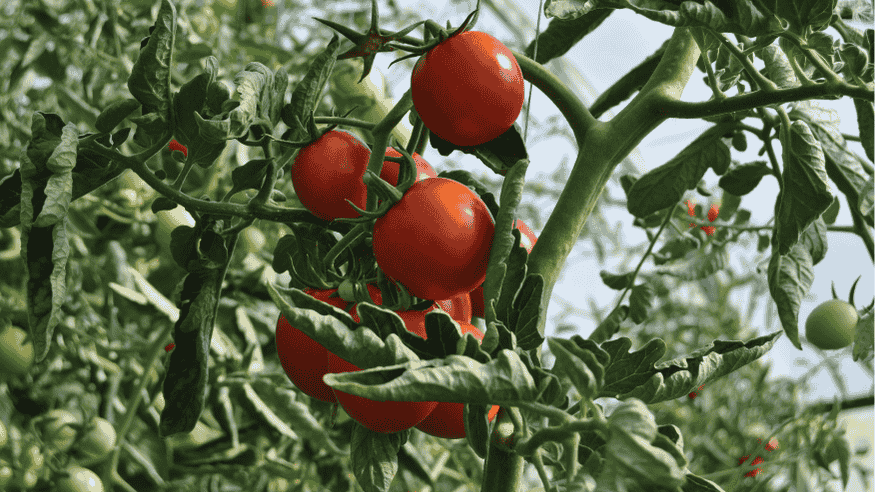
Viral Infections in Plants: Early Signs & Organic Treatments for Tomato and Chili
Share
Tomatoes and Chilies are among the two most widely cultivated crops globally, known for their culinary versatility and nutritional benefits. These crops are also economically important, as they are used for both domestic consumption and export.
However, Tomato and Chili crops are vulnerable to a wide range of viral infections in plants, which can devastate yields and reduce crop quality. These viral diseases can be spread by insect vectors or through infected plant material. Plants are most susceptible to viral diseases during the early growth stages of the crop.
Therefore, early identification and effective organic treatment are crucial for maintaining healthy plants, sustainable harvests, and a chemical-free environment.
In this blog, we’re going to learn more about some common viral infections in Tomato and Chili plants, the plant viral disease symptoms for easier identification, and the most effective organic treatments to keep your plants safe from these infections.
Understanding Viral Infections in Plants
Viral infections in plants are caused by microscopic pathogens or viruses that infiltrate plant cells, disrupt their functions, and hinder normal growth and development. Unlike fungal and bacterial infections, plant viruses cannot be treated with conventional chemical pesticides, and they spread quickly through vectors.
Tomato and Chili plants are especially susceptible to viral infections due to their soft tissues and exposure to tropical and subtropical environments. Viral infections in plants reduce photosynthesis, stunt growth, and compromise fruit development, leading to major losses for commercial farmers and home gardeners alike.
Common Viral Infections in Tomato and Chili
Due to their high susceptibility to viral infections, several diseases caused due to viruses are common in Tomato and Chili plants. Understanding the different viral diseases is important to identify and treat them effectively. Let’s take a look at some of the commonly occurring viral infections in plants of Tomato and Chili.
Viral Diseases Affecting Tomato Plants
Tomato Mosaic Disease: This is one of the most prevalent and well-known tomato diseases. It results in a characteristic mosaic pattern of dark green and yellow patches on leaves, as well as leaf malformation, slow growth, and reduced fruit yield.
Tomato Yellow Leaf Curl Disease: It is another significant tomato disease, especially in warmer regions. It causes severe leaf curling, yellowing, and stunting of the plant. Effective leaf curl virus treatment is essential to get rid of this disease.
Tomato Spotted Wilt Disease: This disease is a serious threat to tomato crops worldwide. It causes yellowing and bronzing of leaves, stem streaking, wilting, and chlorotic ringspots on the fruit. It is spread by thrips, which are tiny insects.
Viral Diseases Affecting Chili Plants
Chili Leaf Curl Disease: Caused by Begomovirus, this disease results in upward or inward curling and crinkling of leaves in affected plants. Such plants produce smaller and deformed fruits and show stunted growth in severe cases.
Chili Necrosis Disease: This is a severely harmful viral infection in plants, as it leads to complete stunting and cessation of plant growth. As it is caused by several viruses such as GBNV and TSWV, controlling this disease is not easy.
Chilli Mild Mottle and Mosaic Disease: This disease gives a mottled and distorted appearance to plant leaves and fruits, making them inadequate for consumption. This disease spreads through common sucking pests like Aphids and Thrips.
Plant Viral Disease Symptoms in Tomato and Chili
Plant viral disease symptoms help you identify the viral diseases in the early stages of plant growth, giving you the best chance to contain and control the infection. By recognizing these symptoms, you can determine whether leaf curl virus treatment or other management actions are needed to treat the disease promptly.
Here are some of the most common signs of viral diseases in Tomato and Chili plants:
Leaf Curling: It is one of the earliest indicators of viral infection in tomato and chili plants. Leaves curl upward or downward, sometimes accompanied by yellowing.
Mosaic Patterns: Most viral infections in plants result in the creation of light and dark green or yellow mosaic patterns on plant leaves.
Distorted Growth: Stunted growth, twisted leaves, and reduced flowering or fruiting are widely observed symptoms when the severity of viral diseases increases.
Chlorosis: Yellowing of leaf veins or interveinal areas without other nutritional deficiencies is known as chlorosis. You may also see brown spots in some plants.
Fruit Abnormalities: Misshapen, undersized, or blotchy fruits with poor quality and quantity are often seen in plants affected by multiple viral diseases.
Organic Treatments for Viral Infections in Plants
Chemical control often proves ineffective against viruses, and overuse may lead to pesticide resistance and environmental harm. The sustainable solution for disease control for tomatoes and chilis lies in using organic techniques and products. Organic treatments are more effective, safe, and environmentally friendly.
Let’s take a look at some key organic treatments that can be used to effectively combat viral infections in plants:
Use of Organic Virucide
Naturally derived organic virucide products like Curcumin-based formulations and plant extracts (such as neem, tulsi, and aloe vera) can help inhibit viral replication and improve plant resistance against various harmful viral diseases.
Removal of Infected Plants
A simple yet effective treatment for viral diseases in Tomato and Chili plants is removing the infected plants immediately. Since viral infections spread quickly across plants, removal is important to keep the remaining plants safe and healthy.
Vector Population Control
Disease-causing viruses generally spread through vectors like Thrips, Aphids, and Whitefly. You can control the population of these vectors organically using yellow sticky traps or insecticidal soaps, implementing a natural leaf curl virus treatment.
Strengthening Plant Immunity
Making your plants more resistant to virus attacks is a great way to prevent viral diseases. You can strengthen the immunity of your plants organically by using compost teas, seaweed extracts, and bio-stimulants.
Intercropping
Intercropping is an organic farming practice where you plant non-host crops like garlic and onion alongside chilis and tomatoes to disrupt vector pathways. These crops keep vectors carrying viruses away from your main plants.
How Octa Organics Help You Fight Viral Infections?
When it comes to managing viral infections in plants, especially in tomatoes and chilis, you need solutions that are effective, reliable, and eco-friendly. Octa Organics offers scientifically tested, plant-based formulations designed to protect your valuable plants from viral damage while enriching the plants for better growth.
Our plant-based, organic virucide product, Viromukt, offers a powerful and chemical-free solution to keep harmful viruses away, nurture strong, productive plants, and support organic farming for a healthier and more sustainable future.

